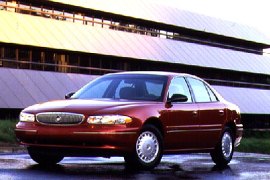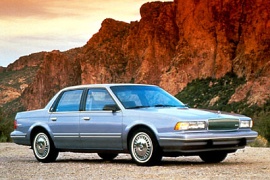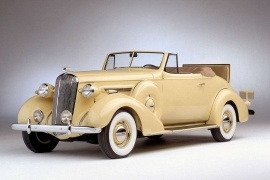BUICK Century Models/Series Timeline, Specifications & Photos
First production year: 1939
Engines: Gasoline
Buick introduced the 1997 Century in late 1996 and was a far departure from its predecessor, which was already an outdated-looking vehicle.
While the fifth Century generation tried to hide its front-wheel-drive architecture of the A-body platform with a cab-rearward design, the 1997 model played the right card and boldly shown a cab-forward look. It was built on an entirely new W-body Gen 2 platform shared with other vehicles such as the Chevrolet Impala, Pontiac Grand Prix, and Buick Regal, to name just a few.
Its rounded design featured sweeping headlights with rounded margins towards the main oval grille on one side and the turn signals on the other. The Century was a fine example of bio-design, but its customers didn't appreciate it since most of them were already AARP members. Buick managed to create a vehicle that was luxurious enough and subtle at the same time.
Inside, the carmaker made a waved-like dashboard with a curved upper side above the instrument panel and sloped-down on the passenger side. Buick offered enough room for four occupants, with wide, comfortable seats at the front and a bench in the rear profiled for two passengers. The base trim levels offered a high-quality velour, while the upper trim levels got a leather-clad interior. The four-spoke steering wheel featured buttons for the sound system and an airbag in the middle.
Under the hood, GM installed a 3.1-liter V-6 engine available in two power options for the U.S. market, while the Chinese customers received a smaller, 3.0-liter unit and even a four-banger paired with a manual transmission.
After almost seven years after introducing the fifth generation of the Century, Buick refreshed it and brought it to slightly modern standards, keeping the car on the showrooms' floors for a few more years before facelifting it again.
When Buick launched the refreshed version of the Century in 1988 for the 1989 model year, sales for the entire lineup (including the coupe and the station wagon) jumped by almost 50%. As expected, the biggest credit went to the sedan, which was highly appreciated by families. With a few updates on styling, interior, and engine, it looked young again, although it wasn't. And its three-speed auto proved that.
With its flush-mounted headlights and integrated, corner-mounted turn signals, the Century said goodbye to the old-fashioned squared lamps. In addition, the chromed grille with its thin vertical slats and the standard badge on the hood made a good impression on customers. Moreover, the greenhouse sported shaved edges, so it didn't look that early-80s anymore. But one of the most appreciated features of the vehicle was the full-length taillights.
Inside, the Century kept its vast interior with velour upholstery for most trim levels. Strangely, some versions were fitted with cranked windows even though the AC was standard. Since the carmaker kept the same dashboard, it featured a squared instrument cluster and a linear speedometer marked to 85 mph (137 kph), and a few other gauges that told drivers if the car needed oil, gas, or a pause to let the engine cool down.
One of the most significant changes happened under the hood, where the former 3.8-liter V6 was replaced by a smaller 3.3-liter unit. Thanks to the fuel-injection system, this new mill produced the same power as the one that it replaced but provided a lower torque. As on any other A-body vehicle built by GM, the Century was offered exclusively as a front-wheel drive affair.
Following a new marketing strategy, Buick renamed its models in the mid-'30s, and the Century nameplate was born as a replacement for the Series 60 model.
There was a new era in the automotive industry. Gone were most of the canvas-top vehicles, and the new body-on-frame with an enclosed cabin for passengers and a separate area for the luggage compartment took over the car arena.
On the outside, the tall and narrow engine compartment was flanked by flamboyant, curved fenders interrupted by the spare wheels. By that time, Buick already understood that the side steps were no longer needed since the cars were not as high as before.
The interior was also clean and simple but finished with expensive materials. Buick built the Century in a few body options, including a sedan, a coupe, and a convertible. Apart from the leather upholstery, the car boasted a radio, ashtray, and a metallic dash panel with three large dials in front of the driver and a clock in front of the passenger.
Like most of the cars from that era, the Century was built on top of a rigid chassis. Its front independent suspension with coil springs added an increase in comfort, while at the back, Buick had to rely on the trustworthy rigid axle with leaf springs. Under the hood, an inline-eight powerplant dubbed Firewall Dynaflash Eight boasted with its overhead valves system. Thanks to this improvement, the 143 hp engine could provide some punchy accelerations for those times and brought the car the nickname of "The banker's hot-rod."


